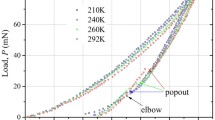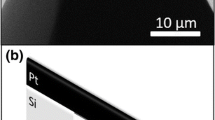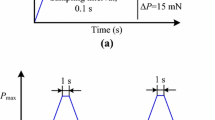Abstract
Nanoindentation-induced phase transformations in both crystalline silicon (c-Si) (100) and ion-implanted amorphous silicon have been studied at temperatures up to 200 °C. The region under the indenter undergoes rapid volume expansion at temperatures above 125 °C during unloading, which is indicated by “bowing” behavior in the load-displacement curve. Polycrystalline Si-I is the predominant end phase for indentation in crystalline silicon whereas high-pressure Si-III/Si-XII phases are the result of indentation in amorphous silicon. We suggest that the Si-II phase is unstable in ac-Si matrix at elevated temperatures and can directly transform to Si-I during the early stages of unloading.



Similar content being viewed by others
References
S. Minomura and H.G. Drickamer: Pressure induced phase transitions in silicon, germanium and some III–V compounds. J. Phys. Chem. Solids 23, 451 (1962).
V. Domnich and Y. Gogotsi: Phase transformations in silicon under contact loading. Rev. Adv. Mater. Sci. 3, 1 (2002).
V. Domnich, Y. Gogotsi, and S. Dub: Effect of phase transformations on the shape of the unloading curve in the nanoindentation of silicon. Appl. Phys. Lett. 76, 2214 (2000).
B. Haberl, J.E. Bradby, S. Ruffell, J.S. Williams, and P. Munroe: Phase transformations induced by spherical indentation in ion-implanted amorphous silicon. J. Appl. Phys. 100, 013520 (2006).
T. Suzuki and T. Ohmura: Ultra-microindentation of silicon at elevated temperatures. Philos. Mag. A 74, 1073 (1996).
D. Ge, V. Domnich and Y. Gogotsi: Thermal stability of metastable silicon phases produced by nanoindentation. J. Appl. Phys. 95, 2725 (2004).
V. Domnich, Y. Aratyn, W.M. Kriven, and Y. Gogotsi: Temperature dependence of silicon hardness: experimental evidence of phase transformations. Rev. Adv. Mater. Sci. 17, 33 (2008).
A.C. Lund, A.M. Hodge, and C.A. Schuh: Incipient plasticity during nanoindentation at elevated temperatures. Appl. Phys. Lett. 85, 1362 (2004).
R.K. Singh, P. Munroe, and M. Hoffman: Effect of temperature on metastable phases induced in silicon during nanoindentation. J. Mater. Res. 23, 245 (2008).
S. Ruffell, J.E. Bradby, J.S. Williams, D. Munoz-Paniagua, S. Tadayyon, L.L. Coatsworth, and P.R. Norton: Nanoindentation-induced phase transformations in silicon at elevated temperatures. Nanotechnology 20, 135603 (2009).
J.C. Trenkle, C.E. Packard, and C.A. Schuh: Hot nanoindentation in inert environments. Rev. Sci. Instrum. 81, 13 (2010).
H. Saka: Transmission electron microscopy observation of thin foil specimens prepared by means of a focused ion beam. J. Vac. Sci. Technol. B 16, 2522 (1998).
S. Ruffell, B. Haberl, S. Koenig, J.E. Bradby, and J.S. Williams: Annealing of nanoindentation-induced high pressure crystalline phases created in crystalline and amorphous silicon. J. Appl. Phys. 105, 093513 (2009).
J.E. Bradby, J.S. Williams, J. Wong-Leung, M.V. Swain, and P. Munroe: Mechanical deformation in silicon by micro-indentation. J. Mater. Res. 16, 1500 (2001).
Acknowledgment
This work has been funded by the Australian Research Council. JEB is the grateful recipient of an Australian Research Council QEII award. The authors would like to acknowledge the assistance of David Munoz-Paniagua with the hot-stage design.
Author information
Authors and Affiliations
Corresponding author
Rights and permissions
About this article
Cite this article
Bhuyan, S.K., Bradby, J.E., Ruffell, S. et al. Phase stability of silicon during indentation at elevated temperature: evidence for a direct transformation from metallic Si-II to diamond cubic Si-I. MRS Communications 2, 9–12 (2012). https://doi.org/10.1557/mrc.2011.24
Received:
Accepted:
Published:
Issue Date:
DOI: https://doi.org/10.1557/mrc.2011.24




